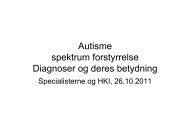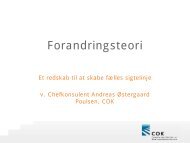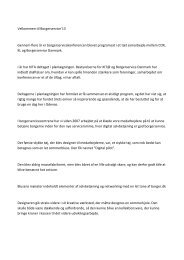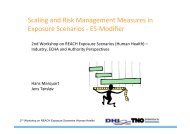11-13 May 2012 Helsingør - Denmark www.networkbio.org
11-13 May 2012 Helsingør - Denmark www.networkbio.org
11-13 May 2012 Helsingør - Denmark www.networkbio.org
You also want an ePaper? Increase the reach of your titles
YUMPU automatically turns print PDFs into web optimized ePapers that Google loves.
DR JANINE T ERLER,<br />
BRIC, UNIVERSITY Of COPENhAGEN<br />
COPENhAGEN, DENMARK<br />
abStract For SPeakerS<br />
Elucidating the molecular networks associated with metastasis<br />
Metastasis is responsible for over 90% of cancer patient deaths due to a<br />
lack of effective therapies against metastatic disease. We require a better<br />
understanding of the underlying molecular processes in order to identify and<br />
develop novel effective therapeutic strategies. We aim to identify the signaling<br />
networks associated with metastasis through several different approaches.<br />
Our goal is to identify key nodes in the network and target these to prevent<br />
disease progression, and translate these findings into the clinic.<br />
One approach we are taking is to identify and compare the signaling networks<br />
and associated genetic mutations in metastatic versus non-metastatic samples derived from patients. In<br />
our model, we have used non-metastatic and metastatic matched human cancer cell lines isolated from the<br />
same patient at different stages. We have performed quantitative mass spectrometry to compare the global<br />
proteome and phosphoproteome, and next generation sequencing to both identify and compare mutations,<br />
and investigate their impact on the signaling networks. We are deploying the NetPhorest and NetworKIN<br />
algorithms to predict phospho-binding modules likely to interact with the identified sites. Additionally, computational<br />
integration of the molecular data with quantitative phenotypic data acquired from high throughput<br />
invasion assays allows us to build predictive models of cancer progression. We are using RNAi to perturb<br />
these networks and refine our models to identify the core network predicted to drive metastasis. We will additionally<br />
integrate data collected from fresh frozen human patient samples. Finally, we will test our predictions<br />
using an in vivo model of metastasis.<br />
The results of this study will aid the development of a network-based therapeutic strategy for the treatment<br />
and prevention of metastatic disease.<br />
abStract For SPeakerS<br />
NEVAN KROGAN<br />
CELLULAR AND MOLECULAR PhARMACOLOGY/CALIfORNIA INSTITUTE fOR<br />
qUANTITATIVE BIOMEDICAL SCIENCES, UNIVERSITY Of CALIfORNIA, SAN<br />
fRANCISCO, CA, 94158<br />
Dr. Krogan is an Associate Professor in the Department of Cellular and Molecular<br />
Pharmacology at the University of California-San Francisco and is<br />
an expert in the fields of functional genomics and systems biology. He was<br />
born and raised in Regina, Saskatchewan, Canada and obtained his undergraduate<br />
degree from the University of Regina. As a graduate student at the<br />
University of Toronto, Dr. Krogan led a project that systematically identified<br />
protein complexes in the model <strong>org</strong>anism, Saccharomyces cerevisiae, through<br />
an affinity tagging-purification/mass spectrometry strategy. This work led to<br />
the characterization of 547 complexes, comprising over 4000 proteins, and represents the most comprehensive<br />
protein-protein interaction map to date in any <strong>org</strong>anism. To complement this physical interaction<br />
data, Dr. Krogan developed an approach, termed E-MAP (or epistatic miniarray profile), which allows for<br />
high-throughput generation and quantitative analysis of genetic interaction data. Dr. Krogan’s lab at UCSF<br />
focuses on applying these global proteomic and genomic approaches to formulate hypotheses about various<br />
biological processes, including transcriptional regulation, DNA repair/ replication and RNA processing.<br />
He is now developing and applying methodologies to create genetic and physical interactions between<br />
pathogenic <strong>org</strong>anisms, including HIV and TB, and their hosts, which is providing insight into the human<br />
pathways and complexes that are being hijacked during the course of infection.<br />
Functional Insights from Protein-Protein and Genetic Interaction Maps<br />
Pathways and complexes can be considered fundamental units of cell biology, but their relationship to each<br />
other is difficult to define. Comprehensive tagging and purification experiments have generated networks<br />
of interactions that represent most stable protein complexes. We describe this work in various <strong>org</strong>anisms,<br />
including budding yeast and in infectious <strong>org</strong>anisms like HIV and TB, and show how the analysis of pairwise<br />
epistatic relationships between genes complements the physical interaction data, and furthermore can be<br />
used to classify gene products into parallel and linear pathways.<br />
22 / INB <strong>2012</strong> • <strong>11</strong>-<strong>13</strong> <strong>May</strong> <strong>2012</strong> <strong>www</strong>.<strong>networkbio</strong>.<strong>org</strong> / 23

















